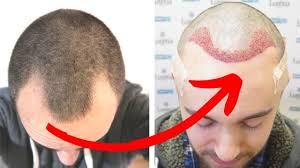If you’ve noticed your hairline receding or thinning patches, you might have wondered about solutions. Hair loss can affect confidence, and many people seek lasting ways to restore their hair. A hair transplant is a surgical procedure that moves hair follicles from one part of the body to balding areas, offering a permanent solution. In Dubai, this treatment has become increasingly popular due to the city’s advanced medical technology and expert practitioners. But how does it work, and is it effective for everyone? Let’s explore the key aspects.
What is a Hair Transplant?
A hair transplant is a procedure where surgeons harvest healthy hair follicles—usually from the back or sides of the scalp—and implant them into areas with thinning or no hair. The two main techniques are:
- FUE (Follicular Unit Extraction): Individual follicles are extracted and transplanted, leaving minimal scarring.
- FUT (Follicular Unit Transplantation): A strip of skin with hair is removed, dissected into grafts, and implanted.
The goal is to create natural-looking hair growth that blends seamlessly with your existing hair. It’s often used for male pattern baldness but can also address hair loss in women.
Why Consider Dubai for a Hair Transplant?
Dubai has emerged as a leading destination for hair restoration, thanks to several factors:
- High Standards: Clinics adhere to strict international safety protocols, ensuring quality care.
- Advanced Technology: State-of-the-art equipment, such as robotic assistance for FUE, improves precision.
- Expert Surgeons: Many doctors have trained globally and specialize in hair transplant techniques.
- Privacy and Comfort: The city’s luxurious healthcare facilities offer a discreet and comfortable experience.
Additionally, Dubai’s multicultural environment means clinics are accustomed to diverse hair types and patient expectations.
The Step-by-Step Procedure
Understanding the process can help set realistic expectations. Here’s a typical outline:
- Consultation: You’ll discuss your goals, medical history, and suitability for the procedure. Surgeons may use scalp analysis tools to plan the transplant.
- Anesthesia: Local anesthesia is applied to the scalp to ensure a pain-free experience.
- Harvesting: Follicles are carefully extracted from the donor area using FUE or FUT methods.
- Implantation: The grafts are placed into tiny incisions in the recipient area, following the natural hair growth pattern.
- Post-Procedure Care: The scalp is cleaned, and instructions are given for aftercare.
The surgery can take 4-8 hours, depending on the number of grafts, and patients can usually go home the same day.
Benefits and Potential Risks
Like any medical procedure, hair transplants have advantages and drawbacks. Benefits include:
- Permanent Results: Transplanted hair typically grows naturally and lasts a lifetime.
- Natural Appearance: When done well, it looks undetectable.
- Boost in Confidence: Restoring hair can improve self-esteem.
However, risks to consider are:
- Temporary Side Effects: Swelling, itching, or numbness in the first few weeks.
- Infection or Scarring: Rare but possible, especially if aftercare isn’t followed.
- Unsuccessful Grafts: Some follicles might not take root, requiring touch-ups.
Choosing an experienced surgeon minimizes these risks significantly.
Finding a Skilled Surgeon in Dubai
Selecting the right professional is crucial for success. Look for:
- Board-certified surgeons with specific experience in hair transplants.
- Before-and-after photos of previous patients to assess results.
- Positive reviews and testimonials from credible sources.
For instance, opting for a hair transplant in Dubai at a reputable clinic can provide assurance through personalized consultations and follow-up care.
The Recovery Process
Recovery is straightforward but requires patience. Key stages include:
- First Week: Expect redness, scabbing, and mild discomfort. Avoid touching the scalp and follow cleaning instructions.
- Weeks 2-4: Scabs fall off, and transplanted hair may shed—this is normal as follicles enter a resting phase.
- Months 3-6: New hair begins to grow gradually.
- Full Results: Visible improvement after 9-12 months.
During recovery, avoid strenuous activities, sun exposure, and smoking to promote healing.
Is a Hair Transplant Right for You?
Ideal candidates for a hair transplant are:
- In good general health with stable hair loss (not actively shedding).
- Have sufficient donor hair on the scalp.
- Realistic about outcomes, as it may not restore full density for advanced baldness.
If you’re unsure, consult a specialist to discuss alternatives like medications (e.g., minoxidil) or non-surgical treatments.
Wrapping Up
A hair transplant in Dubai can be a effective long-term solution for hair loss, combining medical expertise with high-quality care. By researching thoroughly and choosing a trusted provider, you can achieve natural results that enhance your appearance and confidence.

